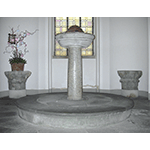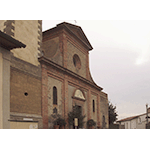Church of Santa Croce - Baptistery
The church of Santa Croce, mentioned in documents dating from at least the year 1132, was originally a simple structure of Romanesque architecture to which was added a portico with Tuscan columns. In honour of Leonardo, at the IV centennial of his birth (1852), it was decided to build the bell tower we see today. In the 1920s, restoration of the entire building in neo-Renaissance style was begun, to the project of Giuseppe Gullino. In 1952 the Oratory of the Compagnia del Corpus Domini was transformed into a baptistery according to the refined project of Giulio Arata, who re-interpreted the old in a sort of rationalist and metaphysical purism.
As proven by an important memorandum written by his grandfather, found in 1931 and published only in 1939, Leonardo was baptized at the font of this church, and not in the baptistery of the Pieve di San Giovanni Battista at Sant’Ansano in Greti, customarily used by the local population in the 15th century. Commemorating this event in today's Baptistery of the Church of Santa Croce is a stone tablet bearing the words of Leonardo's grandfather Ser Antonio da Vinci. In this crucially important document are listed the names of the priest («priest Piero di Bartolomeo da Vinci ») and of no less than 5 godfathers and 5 godmothers, all of whom lived in Vinci, in the vicinity of Leonardo's father's home.
Among the paintings in the church, old tradition attributed to Leonardo a large canvas called the Nativity of the Virgin, which instead has been found to date from 1562 and to be the work of the Mannerist painter Francesco Brina or his circle.
In the Oratory of the Santissima Annunziata as well, located just outside the ancient village of Vinci, tradition attributed to Leonardo the large altarpiece of the Annunciation, which is instead by Fra Paolino da Pistoia, a follower of Fra Bartolomeo.
****************************
Texts by Alessandro Vezzosi
English translation by Catherine Frost
Last update 14/gen/2008





